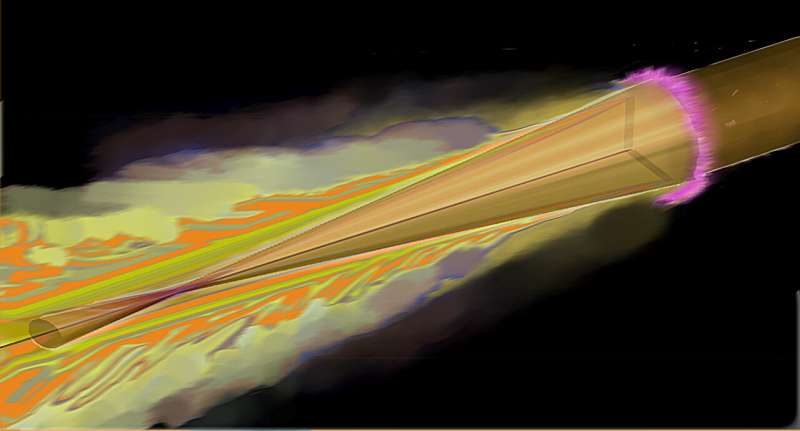
Artistic view of the exploding wire: a powerful stream of high-energy electrons (pink) heats the surface, thus driving subsequent shockwaves that compress the wire radially. Credit: HZDR / T. Toncian
Extreme conditions prevail within stars and planets. The pressure reaches millions of bars, and it can be several million degrees hot. Sophisticated techniques make it possible to create such states of matter in the laboratory—albeit in the blink of an eye and in small volumes.
Today, it needs the most powerful laser in the world, such as the National Ignition Facility (NIF) in California. But there are only a few of these light giants, and opportunities for experiments are equally rare.
A research team led by the Helmholtz-Zentrum Dresden-Rossendorf (HZDR), together with colleagues from the European XFEL, has now succeeded in creating and observing extreme conditions with a smaller laser. At the heart of the new technology is a copper wire, which is finer than a human hair, as the group reported in the journal Communication in Nature.
Today, experts fire very high-energy laser flashes at a sample of material, usually a thin foil. Because of this, the surface material suddenly heats up. This creates a shock wave that travels through the sample. This compresses the material and heats it.
Within a few nanoseconds, conditions such as those inside a planet or in the shell of a star appear. This small window of time is sufficient to study the phenomenon using special measurement techniques, such as the very powerful X-ray flashes of the European XFEL at Schenefeld near Hamburg, Germany.
With the most powerful X-ray laser in Europe, HZDR leads an international user consortium called HIBEF—Helmholtz International Beamline for Extreme Fields. Among other things, this consortium operates a laser at the High Energy Density (HED-HIBEF) experimental station, which generates ultra-short pulses of not particularly high energy—only about one joule. However, at 30 femtoseconds, they are so short that they achieve an output of 100 terawatts. The research team used this laser at HED-HIBEF to fire a thin copper wire, only 25 micrometers thick.
“We were then able to use the powerful X-ray flashes from the European XFEL to observe what was happening inside the wire,” explained Dr. Alejandro Laso Garcia, lead author of the paper. “This combination of short-pulse laser and X-ray laser is unique in the world. It is only because of the high quality and sensitivity of the X-ray beam that we observed an unexpected effect.”
Pure shock waves
In a series of measurements, the scientists systematically varied the time interval between the laser flash effect and the X-rays emitted. This made it possible to record a detailed “X-ray film” of the event.
“First, the laser pulse interacts with the wire and generates a local shock wave that passes through the wire like an explosion and eventually destroys it,” explained HIBEF department head Dr. Toma Toncian “But before that, some of the high-energy electrons that are created when the laser hits, go along the surface of the wire.”
These fast electrons rapidly heat the surface of the wire and generate additional shock waves. Then they run from all sides to the middle of the wire. For a brief moment, all the shock waves collide there and generate very high pressure and temperature.
Measurements showed that the density of copper in the center of the wire was briefly eight to nine times higher than “normal,” cold copper.
“Our computer simulations suggest that we have reached a pressure of 800 megabars,” said Prof. Thomas Cowan, director of the HZDR Institute of Radiation Physics and initiator of the HIBEF consortium. “That corresponds to 800 million times atmospheric pressure and 200 times the pressure that prevails inside the Earth.”
The temperature reached is also enormous by terrestrial standards: 100,000 degrees Celsius.
Perspectives for nuclear fusion
These are conditions close to those in the corona of a white dwarf star.
“Our method can also be used to achieve conditions like those inside large gas planets,” emphasizes Laso Garcia. This includes not only well-known giants such as Jupiter, but also a large number of distant exoplanets discovered in the past few years. The research team has now also specified wires made of other materials, such as steel and plastic.
“Plastic is primarily made of hydrogen and carbon,” Toncian said. “And the same elements are found in the stars and in their corona.”
The new measurement method should not only be useful for astrophysics, but also for another field of research. “Our experiment shows in an impressive way how we can generate very high densities and temperatures in different types of materials,” said Ulf Zastrau, who heads the HED group at the European XFEL. “This will take fusion research an important step further.” Several research teams and start-ups around the world are currently working on a fusion power plant based on high-performance lasers.
The principle: Powerful laser flashes hit a fuel capsule made of frozen hydrogen from all sides and ignite it, with more energy coming out than put in.
“With our method, we can observe in detail what happens inside the capsule when laser pulses hit it,” said Cowan, describing future experiments. “We expect that this could have a significant impact on basic research in this area.”
More information:
Laso Garcia, A. et al. Cylindrical compression of thin wires by irradiation with a Joule-class short-pulse laser. Communication in Nature (2024). DOI: 10.1038/s41467-024-52232-6. www.nature.com/articles/s41467-024-52232-6
Provided by the Helmholtz Association of German Research Centers
Quote: Laser and X-ray combo creates star-like conditions inside a hair-thin wire (2024, September 12) retrieved September 12, 2024 from https://phys.org/news /2024-09-laser-ray-combo-star-conditions.html
This document is subject to copyright. Except for any fair dealing for the purpose of private study or research, no part may be reproduced without written permission. The content is provided for informational purposes only.
#laser #Xray #combo #creates #starlike #conditions #hairthin #wire